BEEF CATTLE SHOWMANSHIP
BEEF CATTLE SHOWMANSHIP
Quiet! Calm! Alert! Show every second. Plan ahead; show your animal to its best advantage. Divide your attention between your animal and the judge, and nothing else.
Showmanship is more than entering the show arena during the fair or livestock show. It includes all the hard work that exhibitors put into their project from the first day they purchase their animal. Many factors enter into the equation for a successful showman, including halter breaking, nutrition, the skill of the showman, and the daily care and grooming. All the hard work done throughout the year will be worthwhile on show day.
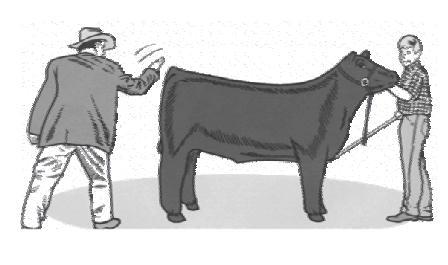 Judge giving comments to exhibitor.
Judge giving comments to exhibitor.
Grooming Beef Cattle
- Trim all four feet as necessary, so the animal stands on its toes. The last time should be about three weeks before the show. This job can be difficult and dangerous. If you do not know how, have someone show you. Always clean the hooves of the animal before showing. Polishing the hooves is optional. (Mineral oil or linseed oil work well.) If conditions are dusty, leave the feet dry.
- Decide whether or not to clip the head. If it would look better, clip it. Steers and polled animals usually have their heads clipped. Clip closely and smoothly a week or 10 days before the show. Blend in at the throatlatch. Trim from the top down until you are experienced. Beginners should always clip with the hair rather than against it.
- Trim the long hairs off the back of the hocks to emphasize a sound, straight, correct leg. Clip the brisket with the hair to avoid leaving jagged edges. Do not clip to the skin. Clip the tail: Begin clipping the tail at the point above the switch where the twist begins to break. Blend the hair on the tailhead into the rest of the body with the use of scissors, comb and clippers.
- Clipping the long guard hairs short to the belly makes the animal look trimmer and taller.
- Trim the long guard hairs on the backline to emphasize straight lines and a level back. Clip deeply enough to straighten the topline and add length to the back but leave enough hair to still look natural. Feel for the base of the crest as your forward limit.
- Decide whether to clip the ears. Study your animal and decide which way would be most attractive. Leave the hair that grows inside the ear.
- Wash your animal several times, but always have it dry at show time. Be sure to use a mild soap. Rinse thoroughly. Never show the animal wet, dirty or full of oil. Wash your animal for the last time early enough for the hair to dry.
Showing Beef Cattle
Equipment:
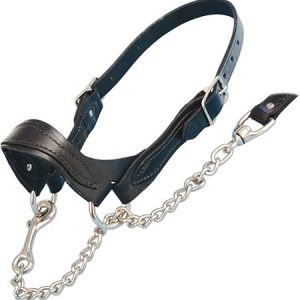
Leather Show Halter - A leather show halter is used in the show ring to give a professional presentation
of your animal. Some judges prefer to black cattle to wear black halters, red critters
to wear brown halters.
Make sure that your show halter is the correct size for your animal! When on the animal’s head, the nose band should be halfway between the eyes and the muzzle. Your halter should be clean and shined and the lead strap when hanging down with the animal’s head held up and 5-6 inches higher than the ground. (*This is to avoid tripping and getting tangled up.)
When leading your animal, the shank should be held tightly close to your animal’s head with your right hand so that you can feel all the movements of your animal. The remainder of the shank can be left to hang so that you have one hand on the halter. Judge’s opinions can differ on the proper way the exhibitor should lead their animal. Do what is most comfortable for you. (NEVER coil or loop the lead strap around your hand.
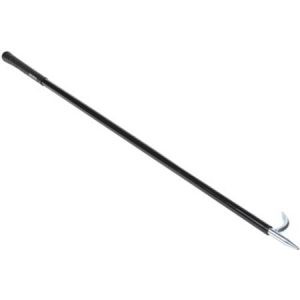
Show Stick: The show stick is used to place the animal’s feet. When walking, the show stick
is held in the left hand, perpendicular with the pointed end downwards towards the
ground. Do not sure your show stick as a walking stick. Keep your show stick off the
ground. Your show stick should be chin height or long enough for you to reach the
back legs of your animals while standing at its head. The show stick should fit the
show person. A show stick that is too long or too short for the show person can be
a hazard.
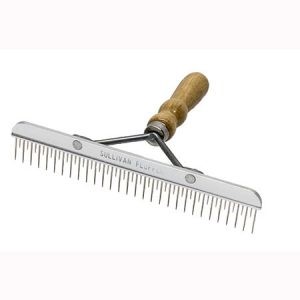
Scotch Comb – A scotch comb should be carried in the back right-hand pocket with the teeth of the comb facing inwards to the showman’s body. The comb is used to place the animal’s hair back in place after the judge has run their hands over the animals hide. Combs can be plastic or metal. Some shows require that scotch combs are plastic to reduce injury, be sure to check your show rules to see what is required.
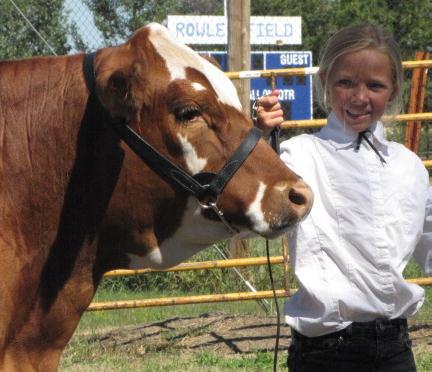
USING THE SHOW HALTER: There are some frequently observed mistakes associated with the use of the show
halter. Proper adjustment of the halter to the animal’s head will give you the best
control over your animal. The nose piece should be 2 inches below the animal’s eyes
or midpoint of the bridge of the nose, between the nose and the eyes. The lower the
nosepiece is on the bridge of the nose, the less control an exhibitor will have of
the animal.
Showing Procedure
- Circle the ring in a clockwise direction at a brisk walk, with your animal’s head up to show alertness.
- While leading the animal, the showman always walks on the left-hand side of the animal’s head, so the judge will have a full side profile view of the animal.
- A good showman knows where both the judge and ring man is at all times. Be looking for hand signals or other directions.
- Always leave several feet between your animal and the next animal when you are leading.
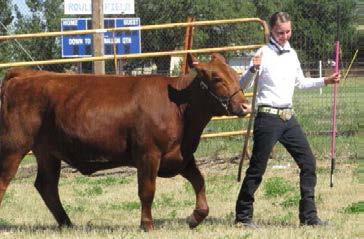 Proper way to hold a show halter, a show stick and lead a beef animal.
Proper way to hold a show halter, a show stick and lead a beef animal.
SETTING YOUR ANIMAL UP:
- When the judge motions for you to stop or pulls you into line, switch the lead strap into your left hand and the show stick into your right hand and begin to set up the animal’s legs. Keep a straight line with the animal that was placed first in line.
- Always leave several feet between you and the next animal.
- Pushing back or pulling forward on the halter will cause the animal to move its feet, due to the change in weight distribution. The show stick is an aid to help you to place the feet. Push backward on the halter and press (do not jab) the soft tissue between the toes with your show stick. Remember it is easier to move a foot backward than to move a foot forward.
- When setting the front feet, use your own foot as a “brake” when asking the front foot to move forward by pulling forward with the halter or use your own foot to push the front foot back. Front feet can also be set with the show stick by applying pressure in the previously mentioned area while pushing or pulling with the halter in the desired direction you want the foot to move.
- When lined up side-by-side, in a straight line, your animal’s legs should be square with each bearing their full share of the animal’s weight.
- When stopped in the ring and lined up head-to-tail or in a side profile, your animal should be set as if a professional photographer is taking a picture. This means that the back-hind leg on the showman’s side should be place ahead a bit. Usually a heel-to-toe relationship works best. That means the heel of the one foot is parallel with the toe of the other foot. The front feet should be square.
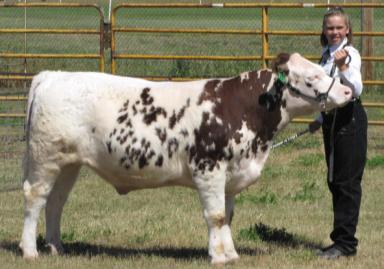
This demonstrates a staggered feet placement; however, the animal is too stretched
out and the front feet should be moved back slightly.
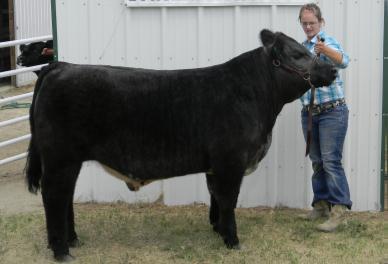
Having the animal’s feet set squarely underneath the body is acceptable when the animals
are positioned side-by-side.
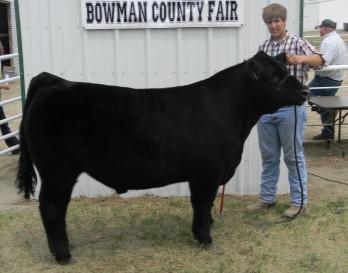
The animal’s front legs are too far underneath the body, giving the animal a shorter
bodied appearance. The front feet should be moved out slightly.
POSING WITH YOUR ANIMAL
- Keep the animal’s head held high and pointed straight ahead. Keep the topline level.
- Find a spot along the underside of the calf and slowly and gently scratch the animal with the show stick. If your animal has a weak top, when the judge is looking at your animal increasing the pressure will keep the animal’s back from sagging.
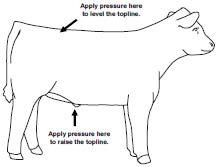 Apply pressure to either the top or underside to keep the back from sagging.
Apply pressure to either the top or underside to keep the back from sagging.
- Standing parallel to or slightly forward of the animal’s head gives the judge an unobstructed view of the animal’s head. A showman that stands beside the neck or shoulder gives a background distraction to the judge.
- FRONT VIEW: It is important you are aware of where the judge is. If the judge comes from the right side of your animal around the front of the animal’s head, when the judge comes even with you, shift your weight on your left foot taking one small step, and turning to look over your right shoulder as the judge walks past. This allows the judge to see more of your animal and lets them know you are aware of their location. Move the opposite way if the judge comes from the opposite direction. Continue scratching your animal the entire time. When the judge is standing in front of your animal observing it, you should stand far enough away from the animal, so a complete view of the animal is available.
- REAR VIEW: When the judge is standing behind your animal, you can set your animal’s hind legs slightly wider than the front legs, to make it appear wider from behind. Apply pressure to the inside of the leg just above the hoof, and they should stand wider.
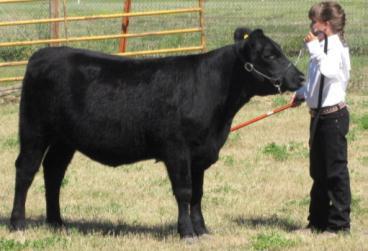
Proper position when judge is walking behind your animal.
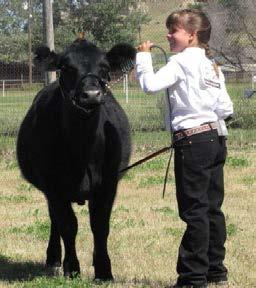
Proper position when the judge is walking by towards the front of your animal.
Smile and keep your animal’s head held high!
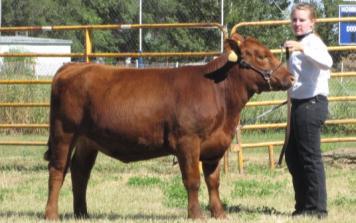
Proper position when the judge is walking by your animal.
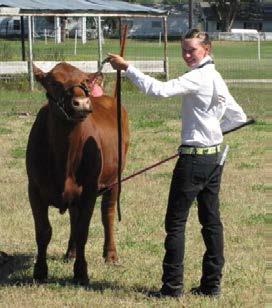
Proper position as the judge walks by the front of your animal.
When instructed to change place in line, lead your animal out forward and turn the animal right. ALWAYS turn into your animal. Never pull your animal around you which changing position; you lose control of the animal and present danger to your fellow competitors.
NOTE: A judging may have exhibitors line up side-by-side and then ask the exhibitor at the far left to move their animal out of line to a different position. In this case, you will make a large turn and pull your animal around you. You will walk behind all the animals in line and to the location instructed by the judge or ring steward. This maneuver is used to allows the judge to see both sides of the animal.
General Guidelines
- Be prepared to answer questions about your animal and the cattle industry.
- Remember you are promoting the cattle industry as well as yourself, you family, your club and 4- H/FFA.
- ALWAYS turn into your animal when changing positions or repositioning your animal.
- Listen to the judge’s reason. If there is something that they pinpoint that you can improve on, take that lesson and either practice it or remember it for your next show.
- No matter the placing at the end of the show, feel confident knowing that you have competed and presented yourself and your animal to the best of your ability and in a professional manner.
- Always maintain a positive attitude and SMILE!
- Refer to all other General Showmanship Guidelines on page 1-3 and your county or show rules.
